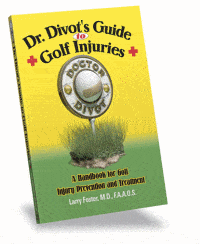Golf is a unique sport in that it is actually more appealing to us as players as we get older. You don’t see too many rugby leagues for folks in their Golden Years, but older golfers do represent one of the fastest growing segments of the golfing population. There are about six million U.S. golfers over age fifty. Furthermore, while older golfers account for about one-quarter of all golfers, they play about half of the total annual rounds in the United States.
For so many reasons, golf is quite popular among older players. The sport’s unique handicap system allows for a “level” playing field, so that low and high handicap players, as well as younger and older players, can play together and still have fun “competing”. Also, as we get older we tend to have more time. The kids no loner have Little League games on Saturday, and the workloads at our jobs tend to lighten up as the young bulls step in—all of which means more time for golf. Finally, we all know that playing golf isn’t cheap, and older players may have the disposable income to make golf more affordable. Maybe life is fair after all.
All this sounds pretty rosy until you consider one fact: older golfers play golf with older bodies, and this can sometimes lead to problems. Large surveys of amateur golfers have revealed that the injury rate is significantly higher for golfers over age fifty (65 percent injury rate) than it is for golfers younger than fifty (58 percent injury rate).
Older golfers are not only more likely to be injured while playing golf, they are also more likely to have so-called incidental injuries—aches and pains from ailment that are not caused by golf but that nonetheless compromise golf performance, and enjoyment. None of this should come as a big surprise. We all carry with us the effects of wear and tear. Wouldn’t it be nice if we could leave those ailments in the clubhouse locker along with our street shoes?
Aging is a poorly understood process that affects all of the body’s systems. Some of the changes we see in the aging individual include decreased performance of the nervous system (a twenty percent slowing of the speed of nerve impulse conduction), cardiac system (a thirty percent drop in heart pumping efficiency) and muscular system (a progressive decline in lean muscle mass by thirty percent and a decrease in muscle strength by 50 percent between age thirty and eighty).
If all this doom-and-gloom statistics about aging makes you want to curl up on the couch and wait for the Grim Reaper, take heart. The fact is that a significant degree of age-related decline in body function can be slowed, and perhaps even prevented, by regular exercise. The fact that you are reading an article about golf rather than one about the finer points of pinochle is a good start. It indicates that despite being older you are physically active and interested in staying that way.
Many sports medicine experts recommend strength training for golfers of all ages—especially for the older golfer. These exercise regimens need not involve expensive gym equipment and personal trainers named Klaus. Home-based programs using light weights, rubber tubing, and so on, can work just fine. To prove this point, there are a few published reports in the medical literature that show how a modest exercise program of light aerobics, stretching, and flexibility (working out two or three times a week for an hour or so each session) can have a dramatic effect on the health of older golfers. After as few as eight weeks, golfers were noted to exhibit decreases in body fat, decreased blood pressure, and up to a fifty percent increase in muscle strength. To make things even sweeter, the exercise program resulted in an average club head speed increase of six percent!
Since the older golfer is not only more prone to injury but also tends to heal more slowly once injured, it is crucial for the senior player to be aware of the factors that lead to injury for all recreational golfers. These are the ingredients to what I call Dr. Divot’s Recipe for Injury:
- Poor physical conditioning
- Overuse (excessive practice or play)
- Inadequate or improper warm-up
- Poor swing technique
So, take the following advice to help ensure that your Golden Years will be ones spent enjoying golf with your friends and not sitting on the sideline in pain. First, consult with your physician about a basic fitness program that will prepare your body for the rigors of the game. Next, avoid the temptation to overdo it—both one the golf course and at the practice range. When you do practice or play, make sure to stretch and warm up thoroughly (a proper warm-up and “head to toe” stretching routine is outlined in Dr. Divot’s Guide to Golf Injuries). Finally, consult your local golf pro for lessons and to identify swing imperfections that may increase the risk of injuries.
By Larry Foster, M.D., F.A.A.O.S. (“Dr. Divot”)
 Larry Foster, M.D., F.A.A.O.S., is a board-certified orthopedic surgeon and self-described golf nut. Trained at Columbia University and the Hospital for Joint Diseases in New York, Dr. Foster is the author of Dr. Divot’s Guide to Golf Injuries—A Handbook for Golf Injury Prevention and Treatment. Written in a humorous “plain-English” style, Dr. Divot’s Guide teaches the reader how to prevent and treat the most common golf injuries. Visit Dr. Divot’s website at: www.doctordivotmd.com.
Larry Foster, M.D., F.A.A.O.S., is a board-certified orthopedic surgeon and self-described golf nut. Trained at Columbia University and the Hospital for Joint Diseases in New York, Dr. Foster is the author of Dr. Divot’s Guide to Golf Injuries—A Handbook for Golf Injury Prevention and Treatment. Written in a humorous “plain-English” style, Dr. Divot’s Guide teaches the reader how to prevent and treat the most common golf injuries. Visit Dr. Divot’s website at: www.doctordivotmd.com.



Leave a Reply